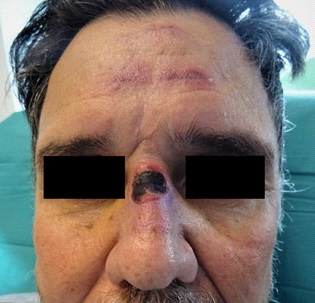
Journal of Clinical Images and Medical Case Reports
ISSN 2766-7820
Clinical Image - Open Access, Volume 3
Tighten up! Facial pressure sore after COVID-19 non-invasive ventilation
Ederer IA*; Rothenberger J; Rieger UM
Department of Plastic and Aesthetic, Reconstructive and Hand Surgery, Agaplesion Markus Hospital, Frankfurt, Germany.
*Corresponding Author: Ederer IA
Department of Plastic and Aesthetic, Reconstructive and Hand Surgery, Agaplesion Markus Hospital,
Frankfurt, Germany.
Email: ines.ederer@hotmail.com
Received : Jan 21, 2022
Accepted : Feb 11, 2022
Published : Feb 18, 2022
Archived : www.jcimcr.org
Copyright : © Ederer IA (2022).
Citation: Ederer IA, Rothenberger J, Rieger UM. Tighten up! Facial pressure sore after COVID-19 non-invasive ventilation. J Clin Images Med Case Rep. 2022; 3(2): 1676.
Description
A 59-year old male patient with no past medical history presented to the emergency department with fever and impaired oxygenation after spending holidays in the Austrian Alps before the country was declared high-risk for COVID-19 infections. Due to clinical deterioration, admission to ICU was necessary for non-invasive ventilation (NIV), as shown in Figure 1. This therapy was sustained for five days while the attachment of the mask had to be tightened up repeatedly due to unintentional leakage compromising effective ventilation. As a result, the patient presented a circumscribed necrosis of about 20 X 15 mm at the dorsum of the nose (Figure 2). The zone of necrosis was clearly related to the tightly fastened bridge of the mask causing ischemia. However, this condition went unnoticed since the patient did not complain about pain on this site while ventilation therapy.
As the presence of COVID-19 was confirmed by rRT-PCR and infectiousness was still highly suspected, surgical therapy (debridement and wound closure with a local flap) was postponed.
Since respiratory failure is commonly seen among COVID-19 patients, we highly recommend regular clinical examination and the early use of cushioned facial dressings (e.g. hydrocolloid) to avoid friction and shear forces beneath the mask. The risk of ischemic tissue necrosis must be considered in any patient - even if there is only a short period of NIV therapy and common risk factors of pressure sore, such as limited sensory reception or microangiopathy, are not present.
Declarations
All authors listed above equally contributed to this manuscript and have no conflicts of interest or any funding source to disclose.


